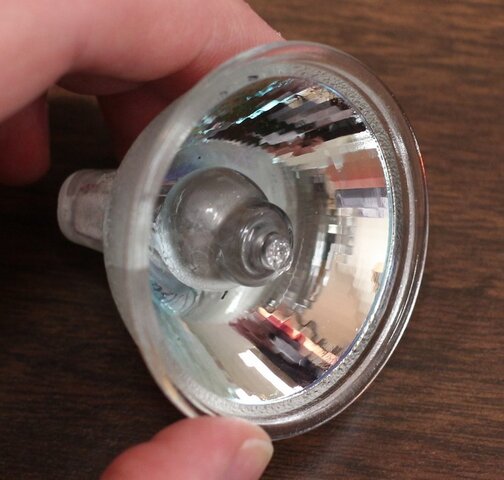FLE Osram/Sylvania #54383 MR-16, Quartz, White Coated
Reflector 360w/82v MR-16 T-3.1/2
MOL 43.3mm GY 5.3 (RM 2P) Any Pos. (
CRI 100) Work Dist. 30.5mm 1,250 Lum 75hr
FLE Ushio #1000542 MR-16, Dich. Quartz, Faceted
Reflector 360w/82v MR-16 cc-8
MOL 44.5mm GY 5.3 Work Dist. 209.6mm,
Base Down to Horz. 3,300°K 75hr
FLE Halco MR-16, Quartz 360w/82v MR-16 2-Pin Any Burn Pos. 3,150°K 75hr
I have two in
stock.
Ballooning of the
globe and heavy deposit of
tungsten on the
globe that etched the glass while also depositing the
tungsten on it. Nobody mentioned yet perhaps bad lamp
socket in causing a
voltage drop resistance that the
halogen gas inside the working lamp was too cool on a low
voltage lamp to re-deposit itself on the
filament. Could also be anywhere in the
voltage train to the lamp a serious enough
voltage drop that the
halogen gas heavy with
tungsten particles is getting board and finding other stuff to do than redeposit - such as etch the glass in finding a hole, and once there is a hole, deposit itself all around the collest part of the lamp - the
globe.. On the other
hand is the ballooning...
Likely the cause but ballooning is often not seen.
Send the lamp question to
Mark from Osram = they got lamp scientists.
Overheating such as a bad fan probably wouldn't cause the
halogen gas to find a cooler spot to etch away at, or make a hole into.
Voltage drop sufficient especially on a low
voltage lamp would if one remembers the classic GE Spectrum lamp or low
voltage lamp catalogue notes on low
voltage lamps.
Low
Voltage halogen lamps should not be dimmed by more than 10% of their rated
voltage since this will result in a reduction in life. Standard
tungsten filament lamps (with no
halogen filling), can be dimmed to zero volts, resulting in virtually endless life. However if low
voltage tungsten halogen lamps are dimmed by more than 10%, the lamp will be operating at too low a temperature and the free halogens in the gas fill, will attack the cooler parts of the
tungsten filament i.e. where enters the quartz or glass
envelope. The
wire at that
point will then be eroded and eventually will fail. So if dimmed by 10% or more low
voltage tungsten halogen lamps will not have an extended life but are unlikely even to reach their rated life. - Philips Website, Optical p1
Operating Temperature = The following maximum and minimum temperatures are suggested for optimum life in
tungsten halogen studio lamps. Operation outside these figures will not necessarily cause immediate failure but will affect life adversely to an increasing extent. Seal temperature - 450°C max. Above this figure the sealing foil oxidizes at a rate increasing with temperature and is frequently the cause of short life due to seal temperature. (The
point to which gas is injected into the
globe.)
Bulb/
Globe - 250°C to 800°C - outside this range the
halogen cycle becomes less efficient and blackening may occur. Temperatures above 1,200°C will cause the
bulb to soften. Pins - 350°C maximum. Above this figure the plating on the pins may lose adhesion and the contact will deteriorate. Such deterioration may form local hot spots which rapidly worsen and may result in arcing and irreparable damage to both lamp and holder. Should signs of this be evident on removal of a failed lamp, it is important that a good contact is restored by replacing the
lampholder before the next lamp is fitted. Otherwise the new lamp will rapidly fail in a similar manner.
Operating Temperature of Discharge Studio Lamps - The following maximum and minimum temperatures are suggested for optimum life. Operation outside of these figures will not necessarily cause immediate failure but will
effect life adversely to an increasing extent. Cap/
bulb interface capsule lamps 450°C maximum. Above this temperature the sealing foil oxidizes at a rate increasing with temperature and is frequently the cause of short life due to seal failure.
Bulb - Capsule Lamps 700°-1,000°C. Sealed Beam Lamps 150°-400°C. Above 1,000°C, quartz may devitrify, which will cause the arc tube to operate below the minimum temperature, the metal halides will not vaporize as required, and lamp performance will be impaired. Pins - 350°C. Above this temperature, see above Quartz
Halogen Pins problems. For sealed beam lamps - to ensure that the above conditions are met, it is important that the lamp does not operate above 400°C even in an enclosed
fitting. It is important to consider the lamp housing from the standpoints of radiation, absorption, and ventilation. Normal variations in ambient temperature do not affect the performance of lamps. Above 175°C (350°F), the solder on
conventional lamps may soften, deform, or melt, and the basing cement may loosen, (cracks are not a normal thing to see.) All glass
wedge base lamps can be operated in lamp ambient temperatures of up to 230°C (450°F). (not-noted source but probably GE/Spectrum.)
Was thinking different things as Derek might post. Not thinking the above either. Agree
return to maker for a perfecly good new lamp to try again in what could be a perfectly bad condition for it. Also check the
voltage train in seeming at least to me a
voltage type of thing in lamp
socket or somewhere the lamp is not getting hot enough. Granted the
bubble is a problem in this theory.




